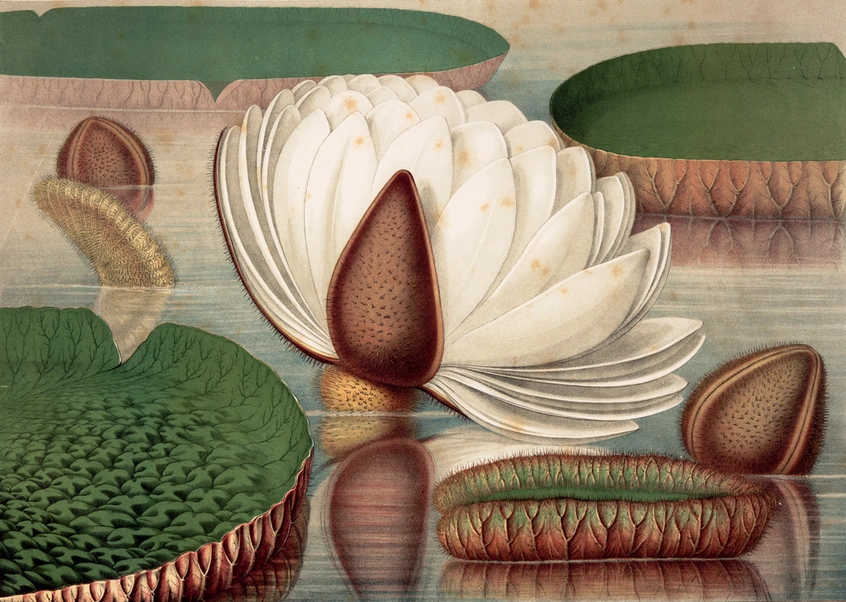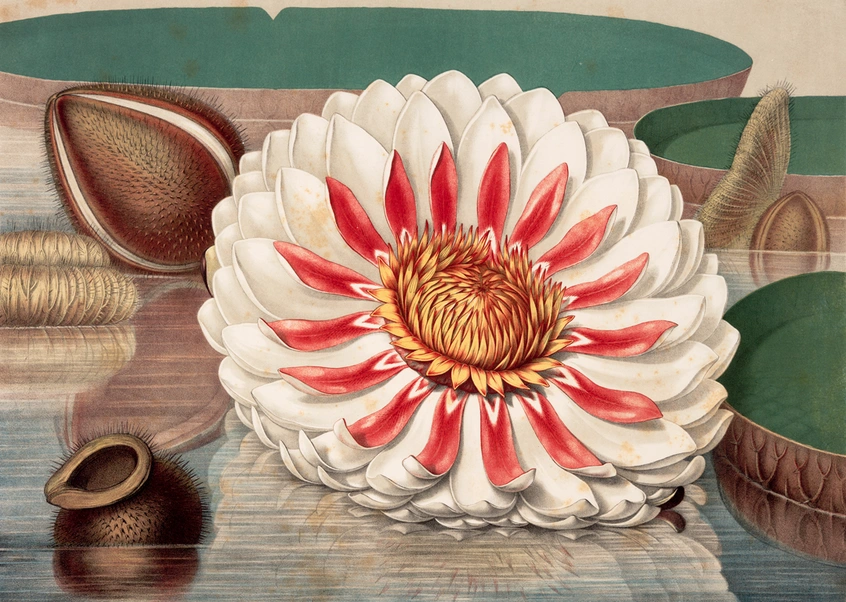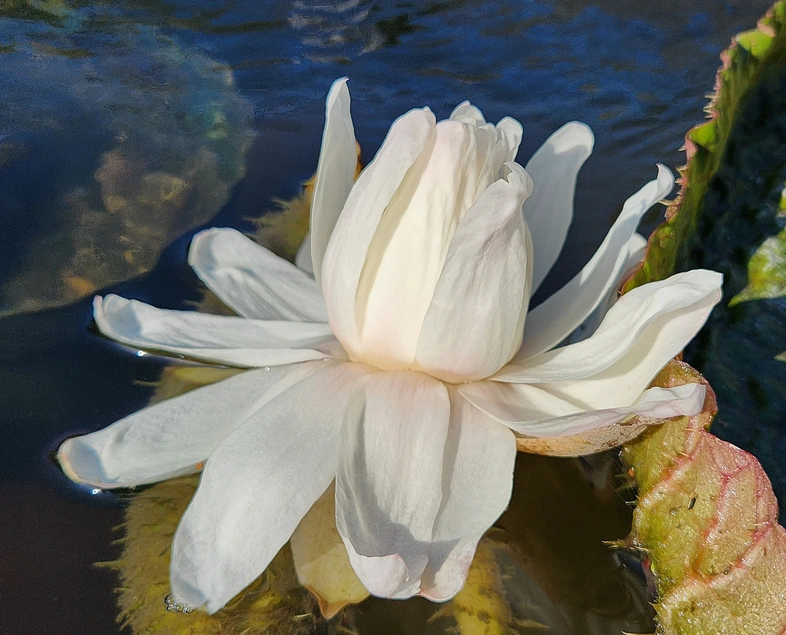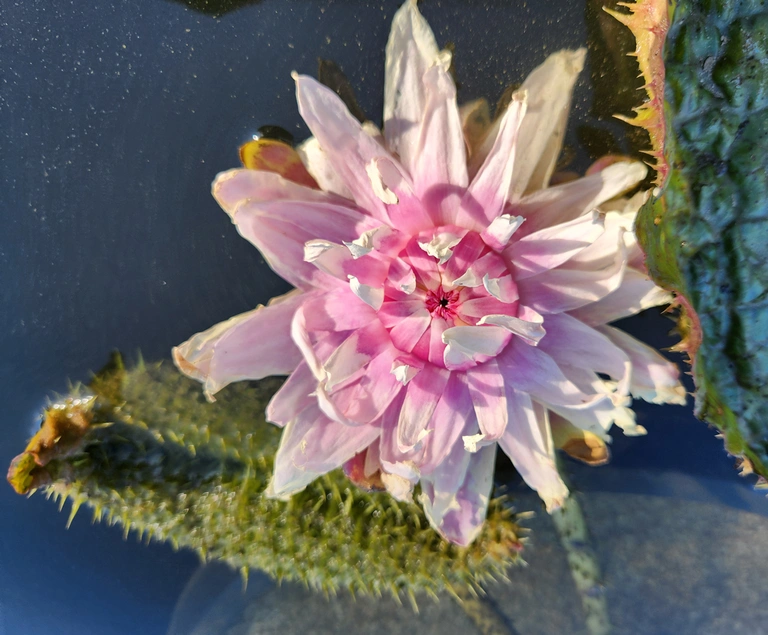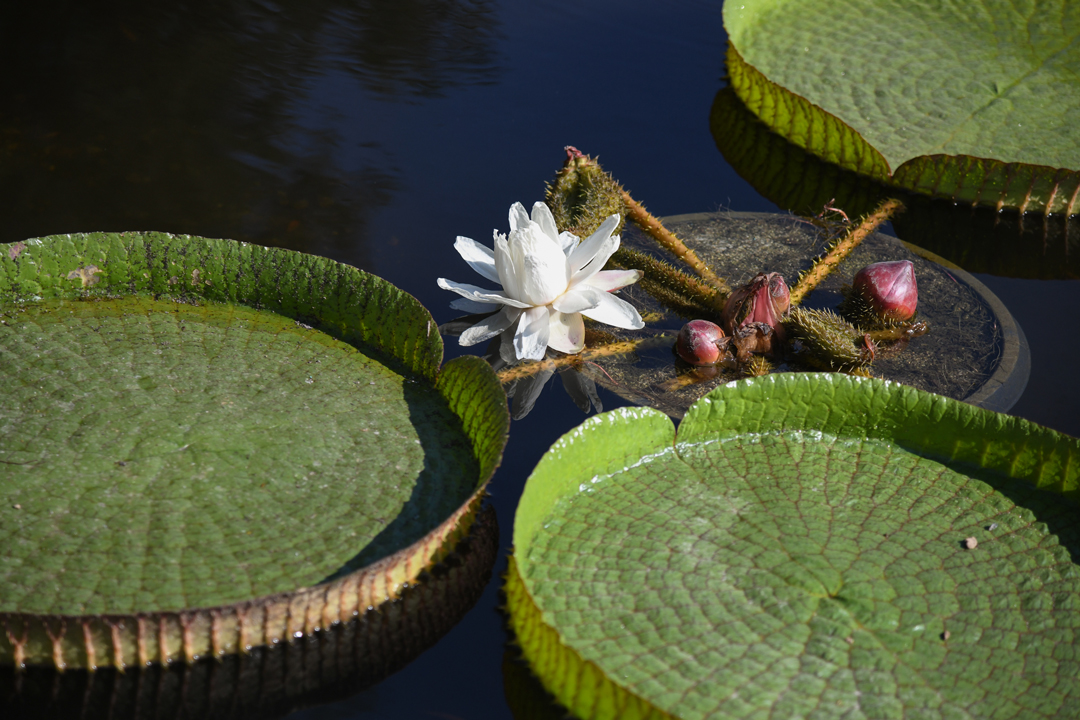
The Victoria water lily flower in its female phase is creamy white with a pineapple-like scent. Photo by Linnea Stephan. | The Huntington Library, Art Museum, and Botanical Gardens.
Now that the Corpse Flower blooming season has wound down at The Huntington, the Victoria water lily—another botanical icon—is hitting its stride. More than a century has passed since these tropical giants last graced The Huntington’s Lily Ponds. Today, you will find several of these remarkable plants growing in the basin of the North Vista’s fountain and in the Lily Ponds on the south side of the property.
In July, three Victoria cruziana plants were added to the fountain, and five V. cruziana hybrids (supplied by pond contractor Jon Rasmussen) were placed in the ponds. The smallest of the three known species of Victoria lilies, V. cruziana has leaves that can grow to a whopping 3 feet in diameter and flowers that are nearly a foot wide. Grown from seeds provided by Ganna Walska Lotusland in nearby Montecito, the V. cruziana plants in the fountain have demonstrated the furious pace at which they can grow. Nursery staff germinated the seeds in March, and the plants have already peaked in size. As annuals, they live for only one season, and before they die, they set seed to produce the next generation. To ensure that there are seeds for the next year, these plants will be hand-pollinated by Botanical staff. Alicia Baugh, the nursery and plant propagation coordinator at The Huntington, oversaw the transfer of the water lilies from the nursery area to the fountain.
“A number of botanical gardens across the country grow these Victoria water lilies,” Baugh said. “Because of their enormous size and unique adaptations, they draw a lot of interest. There is also a friendly rivalry among gardens to see which facility can grow the largest ones. It’s been more than 100 years since we’ve grown these, so we are the new kids in the pond, so to speak, but we are looking forward to being serious contenders.”
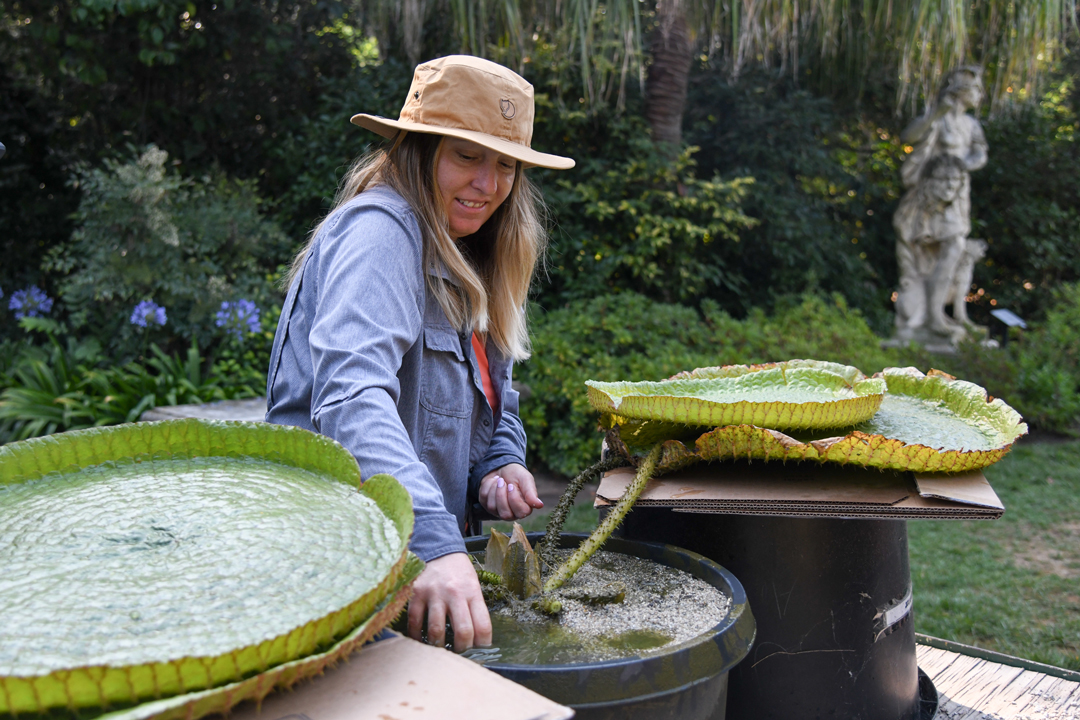
Alicia Baugh, the nursery and plant propagation coordinator at The Huntington, leads the team that transferred the Victoria water lilies from the large nursery tubs in which they were grown to the North Vista fountain. Photo by Linnea Stephan. | The Huntington Library, Art Museum, and Botanical Gardens.
In 1837, the South American genus Victoria was named in honor of Britain’s Queen Victoria, who ascended to the throne that year. The lily’s massive, distinctive leaves, crowned by large, elegant flowers, was seen as the perfect symbol for the monarch.
None of the three Victoria species have yet had their conservation status evaluated. While they are popular plants to cultivate in botanical gardens, wild populations are found in some of the most vulnerable tropical habitats in the world, including the Amazon and the Paraná River basin.
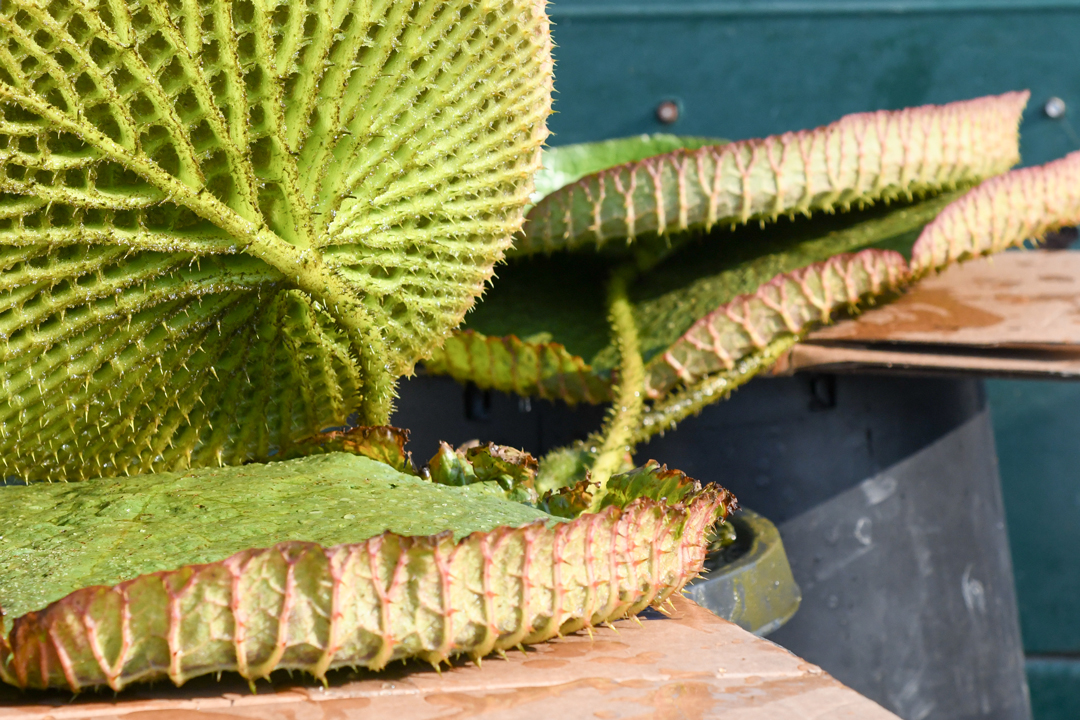
A glimpse under one of the Victoria water lily pads reveals the system of veins that support the leaves and aid in flotation. Photo by Linnea Stephan. | The Huntington Library, Art Museum, and Botanical Gardens.
Among the Indigenous cultures in the plants’ native range, V. cruziana is known by many names. The most common is Irupé, a word of Guaraní origin that means “platter on the water.” The plants’ seeds, rhizomes (or rootstalks), and stems are served as food and, as with many dazzling plants, have inspired numerous legends. A Paraguayan tale recounts the story of a young woman who fell hopelessly in love with the moon, saw its reflection in a pool, fell into the water pursuing her beloved, and drowned. A deity took pity on her and transformed her into a giant water lily, whose flowers open at night so that she could eternally gaze up at the moon.
Early attempts to grow Victoria water lilies in cultivation produced mixed results, as was the case with many tropical plants transported to temperate regions in Europe. In 1849, England’s Kew Gardens was the first facility to grow the plant from seed. Joseph Paxton, gardener to the Duke of Devonshire at Chatsworth, received some of the Kew seedlings and was able to bring the plants to flower later that year. The enormous, fragrant blooms made quite a splash, and the duke had the honor of presenting them to their royal namesake, the queen herself.
The Victoria lilies became botanical celebrities when newspaper images circulated showing Paxton’s 9-year-old daughter sitting on one of the enormous lily pads. The leaf was able to support both the child and the wooden plank on which she sat, together weighing almost 60 pounds.
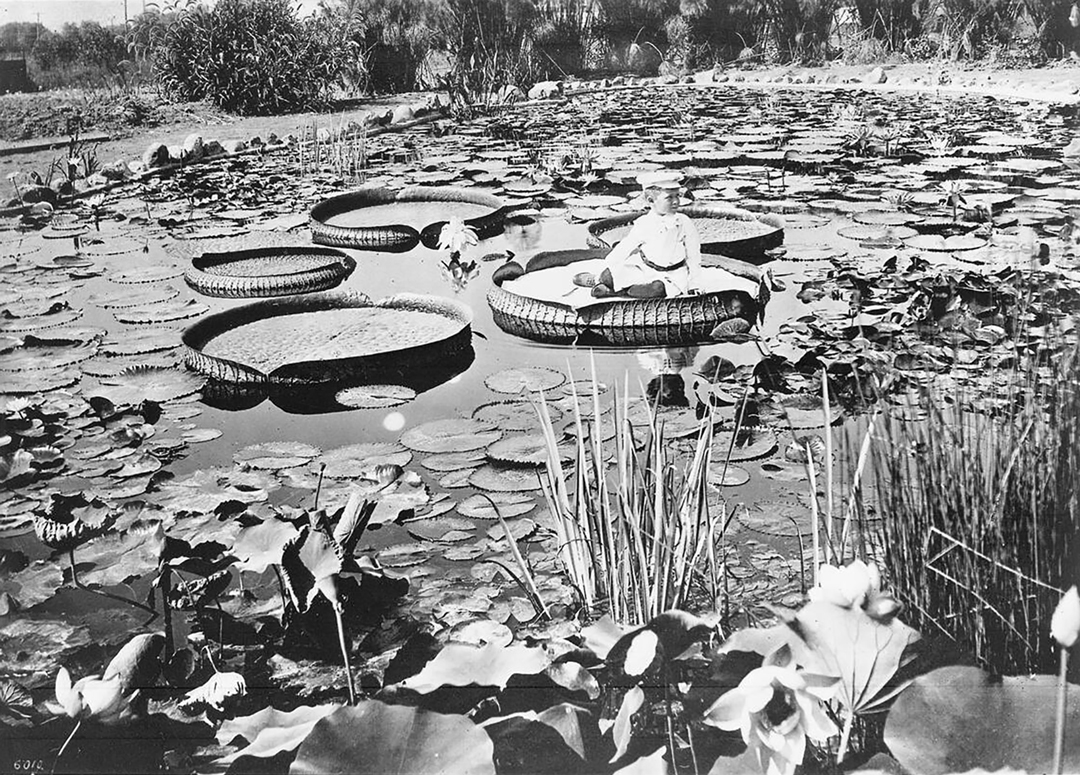
A boy riding on a Victoria cruziana water lily pad in the middle of a pond at The Huntington, ca. 1920. | Photo courtesy of USC and the California Historical Society. Digitally reproduced by the USC Digital Library.
In addition to their size and beauty, the Victoria water lilies possess many intriguing survival adaptations. The rigid veins that support the leaves are filled with air pockets that aid in flotation, and inch-long thorns covering the leaves’ undersides help repel hungry animals. These plants also undergo an unusual reproductive cycle. Like the flowers of many species in the Water Lily family (Nymphaeaceae), the flowers of Victoria water lilies open twice and last for only a couple of days. They first open at night in the female phase, emitting a pineapple-like scent that attracts beetles. The flower then closes, trapping the insects inside, which helps to ensure fertilization. Then the flower transitions to its male phase, and when it opens again, the stamens release pollen on the departing beetles so that they carry it to the next bloom, concluding the process of pollination.
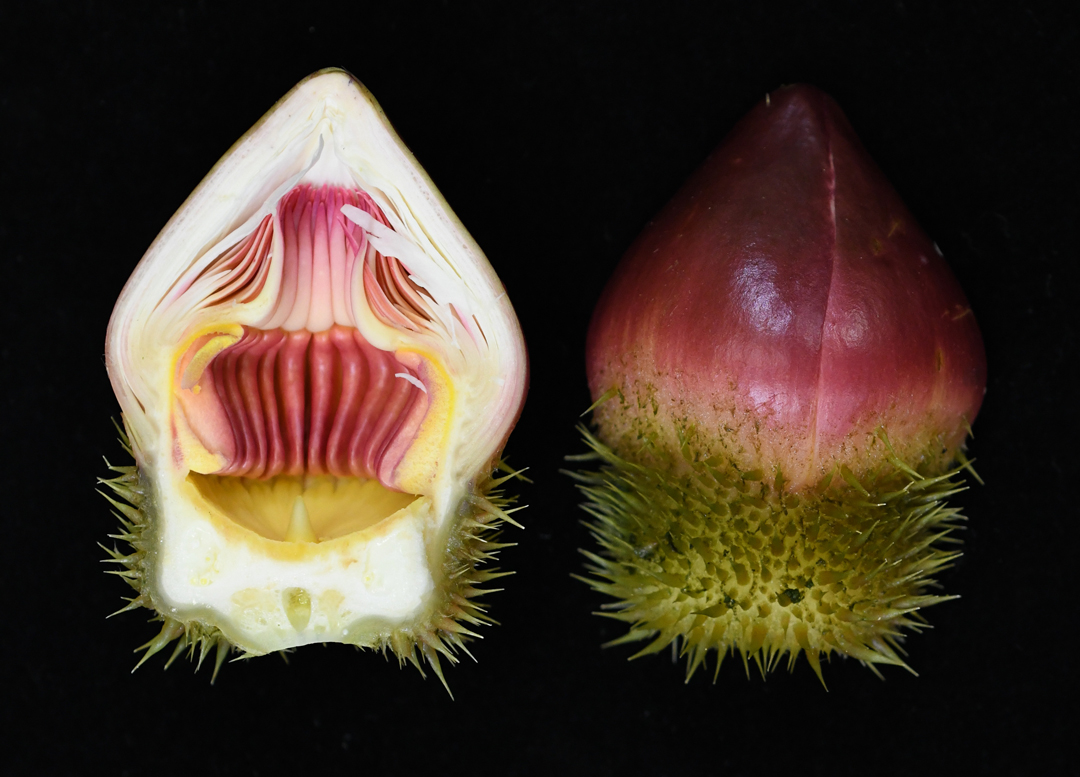
Bisecting a V. cruziana flower bud reveals the pollination chamber at the heart of the flower. When the bloom closes at the end of its female phase, the beetles that pollinate the plant are trapped inside until the flower reopens in its male phase. Photo by Linnea Stephan. | The Huntington Library, Art Museum, and Botanical Gardens.
“In the early 1900s, William Hertrich, Henry E. Huntington’s superintendent of grounds, successfully cultivated Victoria amazonica in one of the Lily Ponds where he had installed a heating system for the purpose,” said Kathy Musial, The Huntington’s senior curator of living collections. “For years we’ve talked about how we might do this, but the logistics of heating the ponds is daunting. Then I saw these lilies growing at Lotusland last year and learned that they could be successfully grown in unheated ponds because of our warm climate. When a Huntington donor who had also seen the Lotusland lilies suggested that we try growing them, we decided to give it a go.”
Returning Victoria water lilies to The Huntington’s collections not only introduces visitors to a charismatic plant with intriguing adaptations and rich cultural connections but also revives a chapter from the gardens’ history.
Sandy Masuo is the botanical content specialist at The Huntington.

